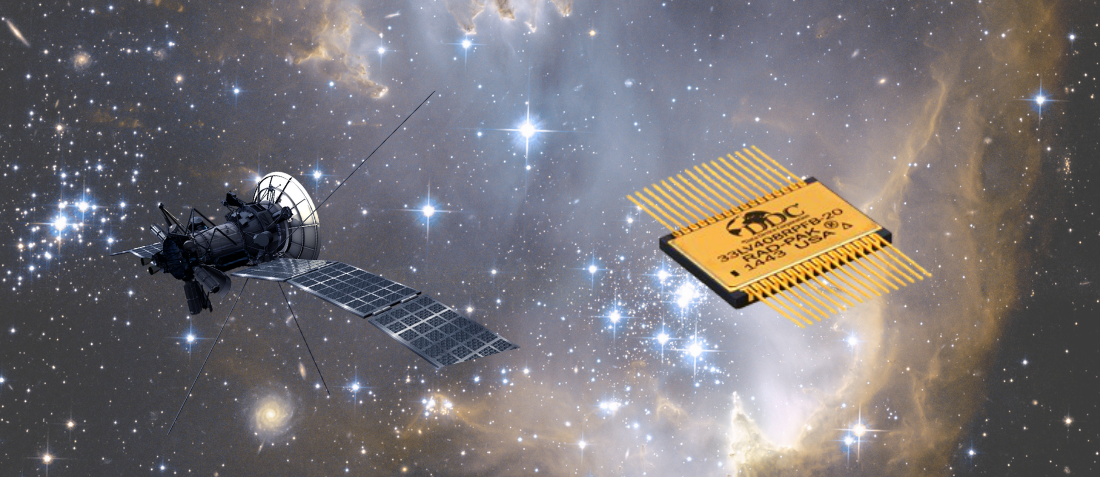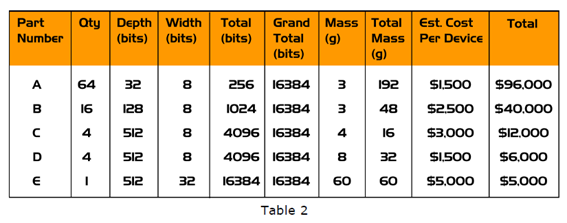
SRAM space memories. A case of study
- Posted by Javier Alejandro de la Ossa Fernández
- On November 11, 2020
- 0
The table that appears below illustrates five different ways a designer can achieve a bank of 16 Mbit or 2 Mbytes of SRAM. It shows three different traditional rad-hard SRAM solutions versus two different radiation enhanced commercial semiconductor solutions.
The upper half of the table describes three standard offerings (parts A, B, and C) from traditional rad-hard SRAM manufacturers. They range in size from the smallest available device, which is 256 kbit, to the largest available device, which is 4 Mbit. The lower portion of the table outlines two offerings from an enhanced commercial semiconductor supplier. Part D represents a commercially available SRAM that has been placed in a shielding package to provide additional TID protection. Part E contains five 4 Mbit commercially available SRAM plus an EDAC chip, each of which has been placed in a similar shielding package as the one applied to part D. EDAC (Error Detection and Correction) is used to detect and correct upset in memory parts.
Each of the three rad-hard SRAM solutions fit the typical rad-hard mould. That is to say, they can withstand 100 krad(Si) and are immune to SEL and SEU up at least 80 MeV. They require no additional enhancement to meet a variety of missions. Part A is a very small memory part. As such, 64 devices will easily fill most of a double-sided 6U VME memory card. In addition, they weigh approximately 192 g and cost 92000 dollars based on street estimates. Thus, aside from the fact that these parts are traditional rad-hard devices, they offer the designer little benefit.
Part B is four times denser that Part A. It, therefore, requires only 16 devices to achieve the target memory size of 16 Mbits. While there is some cost- and mass- reduction associated with moving to the smaller number of packaged devices, the satellite designer will still pay a lot of money (40000 dollars) for the bank of memory, which takes almost one full side of a 6U VME memory card.
Part C is a relatively new type of IC now offered by several traditional rad-hard vendors. It is four times denser than part B and 16 times denser than part A. There are cost and mass improvements over Parts A and B, but the satellite designer pays 24000 dollars for the bank of 16 Mbits of SRAM. This solution will populate approximately 1/3 of a 6U VME card.
Part D is based on commercial SRAM die. Due to the shielded package in which it must be placed, it weighs more than Parts A, B, or C. However, the necessary bank of Part D devices will weigh less than a bank composed of Part A or Part B devices represent a significant cost saving over any of the parts in the upper half of Table 2. It will cost at least 14000 dollars less than the traditional rad-hard solutions. But because it based on a commercial SRAM, it is highly susceptible to upset. As a result, EDAC must be used if upsets are a concern. And the cost EDAC, which varies from application to application, must be considered when evaluating the overall price tag.
Moreover, part D’s TID tolerance is orbit dependent. Some studies suggest that shielding is approximately 10 times more effective in electron- dominated orbits than in proton dominated orbits. This variability requires additional engineering effort that cannot be overlooked when determining the total cost of a system. Part E, which is a multichip-module approach, represents the most unique solution to the proposed SRAM problem. Unlike the four other proposed solutions, this device is made up of six primary active components, all within one packaged product.
Part E has four commercially available SRAM devices that are used for primary memory storage. It also has one additional SRAM die used as check bits for the EDAC, which is the sixth active component. This innovative collection of parts will appear to the system to be an SEU immune part. Consequently, the device will upset less frequently than the traditional rad-hard SRAM. Like part D, part E uses a shielded package for enhancing TID survivability. But significant cost and board space savings highly recommend it; Part E will take up approximately 1/5 of 6U VME board and save 85000, 31000, and 15000 dollars over than parts A, B, and C, respectively.
The designer’s dilemma
There are numerous techniques that can be used to design modern satellite systems. Each method has its pros and cons. Which method or combination of methods is best will be hotly debated in the years to come? The case study outlined here demonstrates the significant cost savings that can be realized when answering the question, “How rad-hard do I need?” and when considering the use of commercially based parts. But commercial solutions can give ample cause for designers to be wary, despite their cost advantages. Many commercially based space semiconductor manufacturers do not make their own silicon. This means they are dependent on other manufacturers for the very heart of their products. Large silicon manufacturers can, and do, cut off smaller suppliers in times of need. Consequently, the reasons that make one commercial semiconductor good for space can be instantly destroyed if a manufacturer decides to alter a part for their own reasons.
Furthermore, commercially based solutions require additional engineering effort by the satellite system designer. Where traditional rad-hard parts come stamped with a guaranteed TID tolerance for every mission, commercial parts need to be tested by designers before they can be incorporated into a design.
Despite these design complications, one thing is certain: space, once the regime of elite military and scientific entities, will soon become the next great commercial frontier. This means satellite systems will have to be faster, better and cheaper. The only way to achieve this is for the space community to find new and innovative approaches to its three fundamental problems – TID, SEL and SEU. As such, the space community can no longer rely solely on traditional radiation-hardened components. Those who do so will most certainly lose the race. On the other hand, manufacturers who rush too quickly to the opposite extreme will lose, as well. Indeed, the numerous reported on-orbit failures of Iridium remain a constant reminder of the necessity to move cautiously towards commercial parts. In the end, the best solution undoubtedly will be a mixture of both old and new methods, with a healthy blend of the design creativity inspired by the constraining environments of paradoxically boundless space.
- Entangled photon sources for quantum communications - December 14, 2022
- Using optical transceiver technology within space vehicles - November 8, 2022
- Issue 224 of ESCC QUALIFIED PART LIST (QPL) - March 21, 2022


0 comments on SRAM space memories. A case of study